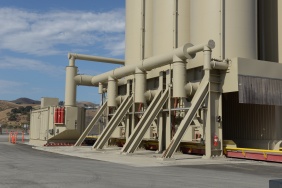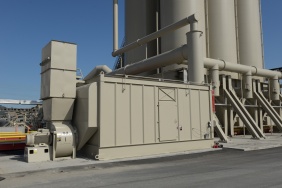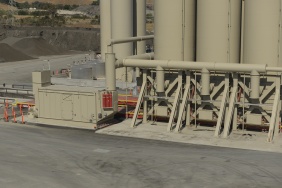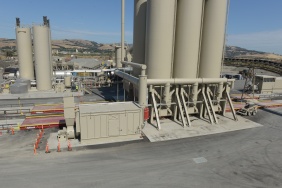- Products
- Emission Control
- ASTEC® Fibrebed Mist Collector
Blue smoke emission and control
Blue smoke is a visible aerosol emission capable of traveling long distances before dissipating sufficiently to become invisible. It is an industry-wide concern for several reasons including regulatory limitations, organized opposition, community concerns, and control equipment requirements.
Visible emissions produced at hot mix asphalt (HMA) plant look bad to the community. People make assumptions about the “smoke” that they see. Their perceptions are often based on a lack of knowledge or incorrect information. In fact, there is no way to know whether a plant is out of compliance by simple visual observation. Nonetheless, visible emissions can trigger complaints by the community, which can in turn lead to permitting and zoning difficulties for new facilities.
TYPES OF BLUE SMOKE EMISSIONS
Process Emissions
Process emissions are those emissions ducted to a single discharge point. They result from plant operations such as fuel combustion. These emissions may include particulate matter, steam, combustion products, unconsumed air, and unburned hydrocarbons (i.e., fuel droplets).
Fugitive Emissions
Fugitive emissions result from such activities as vehicular travel and material transfer between plant components. Fugitive emissions are divided into two major categories:
- Invisible Emissions - Emissions that primarily consist of non-condensable volatile organic compounds (VOCs) that participate in the production of ground-level ozone (smog).
- Visible Emissions - There are two types. The first are visible fugitive dust emissions generated at conveyors, stockpiles, and roadways. Other visible fugitive emissions contain heavier hydrocarbons (compounds made of hydrogen and carbon molecules) that readily vaporize at temperatures around 150°C. They condense in ambient air and adsorb to dust and water particles. These emissions have a characteristic fuel odour.
BLUE SMOKE CHARACTERISTICS
What is it?
In the USA, the EPA conducted extensive testing on gaseous emissions that occur while filling silos and loading trucks. Tests were conducted at a batch plant and a drum mix facility. The emissions were found to contain organic (carbon based) and inorganic particulate matter. Analysis also revealed the presence of carbon monoxide. However, hydrocarbons were found to be the predominant component of blue smoke. These hydrocarbons are collectively categorized as Total Organic Compounds (TOCs).
Emission rates were found to vary with bitumen binder volatility and mix temperature.
Volatile Organic Compounds
Volatile organic compounds (VOCs), a subset of TOCs, are hydrocarbons that readily vaporize at room temperature and pressure. They are produced during the combustion or breakdown of complex hydrocarbons. According to the EPA tests, 94 percent of the compounds present in blue smoke are VOCs. Their presence in blue smoke is of concern because of their contribution to air pollution. These compounds react with nitrogen oxides in the presence of sunlight to form photochemical smog. They also trap heat, which contributes to the so-called “greenhouse effect”.
Hazardous Air Pollutants
Hazardous wastes are compounds known, or suspected, to be dangerous to humans and the environment. The airborne components of these chemicals are known as hazardous air pollutants (HAPs). HAPs produced through combustion are fuel-type dependent, as is the quantity emitted. Approximately 9 percent of the compounds in blue smoke are classified as HAPs.
CAUSES OF BLUE SMOKE
Chemistry of Asphalt
Asphalt is a complex mixture of hydrocarbons that remain after refining crude oil. In addition to carbon and hydrogen atoms, asphalt also contains sulphur, nitrogen, and oxygen. Trace amounts of the metals vanadium, iron, and nickel may also be present.
Distillation Process
Crude oil is the foundation of many organic compounds. It can be asphaltic-based, paraffin-based, or a mixture of the two. Asphaltic crude oil yields asphalt cement from simple atmospheric distillation. Paraffin type crude oil yields asphalt cement only through destructive distillation involving chemical reactions.
Crude oil’s chemical composition, and thus its source, determines what fractions, or compounds, are acquired through distillation. Individual fractions exhibit different behaviours based on their atomic structure.
Asphaltic crude oil is superheated to approximately 600°C during simple atmospheric distillation. The resulting vapours enter a distillation column filled with separation trays for collecting the various fractions. Temperatures within the column decrease with height. Fractions condense according to their boiling point as they rise through the tower. Light fractions include gasoline, kerosene, and fuel oils. Heavy fractions include lubricating oils and heavy gas oil. It is important to note that injecting steam, as a catalyst, will increase the level of separation at lower temperatures. With steam injection, distillation can occur at temperatures as low as 300°F.
Bitumen is a residual compound from the distillation tower.
Some heavy fractions will be subjected to further processing. They are often sent to cracking units. Cracking is the process in which large hydrocarbon molecules are broken into smaller
molecules by applying heat and high pressure. Catalysts, such as steam, can be applied to the process in order to lower the temperatures required. Lighter fractions acquired by cracking
are sent to another distillation tower for separation.
Despite processing, all light fractions are never completely removed from bitumen. The quantity remaining depends on the original crude oil and the degree of processing that has taken place. Bitumen viscosity, is dependent on the quantity of light fractions retained after
processing. Studies of crude oils from around the world show that different asphalts will contain varying quantities of light fractions even after undergoing the same processing.
Bitumen hardness greatly affects mix performance. It is directly related to the amount of light fractions retained by the bitumen. Hardness increases as the quantity of light fractions decreases.
In order to meet hardness specifications (the bitumen’s pen, or penetration number), artificial softening of the asphalt cement may be required. The softening process involves blending a bitumen with softer bitumen’s, if available, or other light fractions. This increases the quantity of light fractions present that may vaporize under appropriate conditions. The smoke temperature of the bitumen is dependent on the light fractions present.
Temperatures at hot mix asphalt (HMA) facilities are higher than many hydrocarbon boiling points. Vaporization may occur during the production of hot mix when conditions are favourable and light fraction vaporization can cause blue smoke formation during mix production and storage.
Warm mix asphalt (WMA) systems such as the Astec Green Pac System as well as providing reduced energy consumption by reducing mix temperature, also lower emissions and can eliminate visible smoke. Unfortunately, many technologies for warm mix production rely on additives, special bitumen, special procedures and/or special bitumen delivery systems to achieve low viscosities at low temperatures. The additives are expensive and add significant cost per ton of mix. Astec warm mix systems eliminate the need for expensive additives and special bitumen’s by mixing a small amount of water into the bitumen to create microscopic bubbles. These small bubbles act to reduce the viscosity of the bitumen coating on the aggregate allowing the mix to be handled and worked at lower temperatures
Asphalt Binder Additives
Anti-strip additives can also affect blue smoke formation. These compounds alter the chemical composition of a binder by adding light fractions and typically, the smoke temperature of a binder is lowered when using anti-strip additives.
Recycled Materials
There are significant economic advantages to using Reclaimed Asphalt Product (RAP). RAP usage proportionally decreases the quantity of virgin aggregate and bitumen in a mix. However, RAP is another source of hydrocarbons. When blended with superheated virgin aggregate, RAP melts and steam is released. At sufficiently high mix temperatures, steam can initiate hydrocarbon vaporization from the RAP. These hydrocarbons will form blue smoke if allowed to condense. Smoke formation from recycle mixes generally results from excessive mix temperatures. Extended periods of precipitation can cause fluctuations in the RAP moisture content. The resulting increase in steam volume can enhance smoke production, depending on the light fractions present in the recycle material. It is advantageous to take steps to minimize RAP moisture which can be achieved through various methods, including paved or covered stockpile areas and proper stockpile management.
Mixer and Dryer Designs
Mixer or dryer design also influences blue smoke formation. In a parallel-flow drum mixer, parallel flow RAP dryer and some aggregate dryer drums with recycle addition breaching rings; mix / RAP is showered through the hot gas stream being pulled through the drum. Steam in the drum can initiate hydrocarbon vaporization. In such drums, all gases are ducted a single emission point, typically the baghouse exhaust stack. Vaporized hydrocarbons present in the gas stream will condense upon ejection from the stack resulting in blue smoke emissions being appreciably higher for this type of plant.
In the ASTEC® Double Barrel® drum mixer, RAP and bitumen are injected in the mixing chamber, away from the hot exhaust gases in the inner drum. Steam is released as the RAP mixes with superheated aggregate. Hydrocarbons vaporized in the mixing chamber are pulled into the inner drum by the exhaust fan, where they are consumed by burner flame. The Double Barrel® drum mixer has been designed to meet emission requirements by eliminating the potential for blue smoke formation while running up to fifty percent RAP.
Air Exposure
Blue smoke can form at material transfer points because of exposure to ambient air. As mix falls, through a discharge gate for example, it does not remain in a slug. The turbulent fall of the mix exposes a larger surface area, thus allowing for even greater interaction with cool air. Any vaporized hydrocarbons that have been trapped in the mix are then released, blue smoke forms as they condense.
CONTROL METHODS
Need for Control
While HMA facility emissions are lower than most other industries, the implementation of blue smoke control may still be warranted. In future, blue smoke systems are likely to become a standard pollution control device at HMA facilities, either due to local community pressure or regulatory requirements.
DISPOSABLE METHODS
Effective smoke collection involves sealing all material transfer points. This eliminates the opportunity for vaporized hydrocarbons to condense in ambient air. Pick-up points are positioned at material transfer locations, such as atop batchers and the drag discharge
chute. Dampers in the ductwork at each pick-up point are used to balance airflow. They may be manual or automatic depending on the overall system set-up. A radial blade centrifugal fan is used to transport contaminated air through the ductwork. A damper is located at the fan inlet to control suction.
Because hydrocarbons are essentially fuel droplets, a logical method of disposal is incineration.
Smoke collected at the mixer and sealed silo tops can either be routed to the burner or a collection unit.
The captured smoke is ejected from a dispersion ring encircling the burner. The main system exhaust fan pulls the hydrocarbon-laden air into the flame of induced-air burners. Smoke particles are blown directly into the flame of forced-air (total air) burners by the scavenger
fan.
COLLECTION METHODS
Blue smoke formation at the loadout zone is problematic for both continuous mix and batch plants. Collection involves surrounding the discharge gate on three sides with horseshoe-shaped intake hoods. Automatic dampers synchronized with the discharge gates regulate the airflow through the intake hoods ensuring that scavenging occurs only at the silo in use.
The air volume captured at the loadout zone limits control options. Burner excess air limits generally rule out incineration, therefore smoke from the loadout is typically routed to an alternate control device.
Electrostatic Precipitator
An electrostatic precipitator can be utilised to remove hydrocarbons from the gas stream. Incoming gases flow past a series of electrodes suspended in the passage through the first stage of the unit. The electrodes are supplied with high-voltage DC power that ionizes (causes to have a negative electrical charge) the particles as they pass. The gases then flow past collector electrodes in the second stage of the device. Collector electrodes
have a positive charge that attracts the ionized hydrocarbons, removing them from the gas stream. Treated air is exhausted to the atmosphere. Collector electrodes must be cleaned regularly to remove particle build-up.
Media-Type Filtration System
In a media-type filtration system blue smoke is pulled through a unit containing an assembly of disposable, pleated filter cartridges. Vaporized hydrocarbons and steam cool as the gas stream enters the unit. As smoke particles condense, some collect in a sump located in the expansion chamber. Filter cartridges collect the remaining particles as the gas stream flows through the unit.
Filter cartridge units consist of two filtration stages. The first stage involves preliminary filtration of condensed droplets via impingement filters. Primary filtration of the gas
stream involves second stage oil mist filters. Oil collects on both the preliminary and primary filters.
Media-type filtration systems require routine filter replacement to ensure proper operation.
For more information about our range of products please call us on +44 (0)1440 821155 email us at sales@bgeuropa.co.uk or use our contact section.







